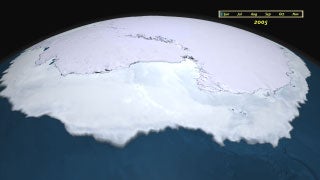 This post is by James Wang, Ph.D., a climate scientist at Environmental Defense Fund.
This post is by James Wang, Ph.D., a climate scientist at Environmental Defense Fund.
This month, while Arctic sea ice hits its annual wintertime high (such as it is – see last week’s post), Antarctic sea ice reaches its summertime low.
We’ve already posted about the British Antarctic Survey’s report of a vast ice berg on the verge of breaking off the Wilkins Ice Shelf. Here’s more on what’s happening at the South Pole from NASA’s recent briefing on polar sea ice.
Although the Arctic and Antarctic are both at the Earth’s poles, they’re not mirror images of each other. There are some fundamental differences between them. Antarctica is a land mass surrounded by an ocean, while the Arctic is basically an ocean surrounded by land.
Unlike the Arctic, the Antarctic typically has little perennial sea ice. There are two main reasons:
- Because there are no surrounding continents, Antarctic sea ice can float northward into warmer waters where it melts.
- Because it’s at a lower latitude, Antarctic sea ice receives more direct sunlight and heat in summer.
Almost all the sea ice that forms during the winter melts during the summer.
Click to view Windows Media Viewer streaming video.

Also unlike the Arctic, which is one of the fastest-warming places on Earth, surface measurements and satellite data in Antarctica haven’t revealed overall trends in temperature or sea ice area. Warming and sea ice loss in some areas – notably the Antarctic Peninsula, where the iceberg is breaking from Wilkins Ice Shelf – have been balanced by little temperature change or even cooling and sea ice gain in other areas.
Still, that doesn’t prove there’s no warming trend in Antarctica. Satellite data has only been available since the 1970s. Earlier observations from whaling ships suggest that there was a greater sea ice area before satellite observations were available.
If Antarctica isn’t warming – or if it’s warming at a slower rate – it may be due to the atmospheric vortex circulation that surrounds it (from being a land mass centered at a pole and surrounded by ocean). This tends to hold in cold air. But that’s just one hypothesis that scientists are exploring.









